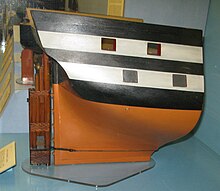This is an old revision of this page, as edited by AnomieBOT (talk | contribs) at 23:31, 27 April 2018 (Rescuing orphaned refs ("alt.usage.english" from rev 838575288)). The present address (URL) is a permanent link to this revision, which may differ significantly from the current revision.
Revision as of 23:31, 27 April 2018 by AnomieBOT (talk | contribs) (Rescuing orphaned refs ("alt.usage.english" from rev 838575288))(diff) ← Previous revision | Latest revision (diff) | Newer revision → (diff) Not to be confused with Jury tampering.Jury rigging is both a noun and a verb describing makeshift repairs made with only the tools and materials at hand. Its origin lies in such efforts done on boats and ships, characteristically sail powered to begin with. After a dismasting, a replacement mast and if necessary yard would be fashioned and stayed to allow a craft to resume making way.
Etymology
The adjectival use of "jury", in the sense of makeshift or temporary, has been said to date from at least 1616 when according to the 1933 edition of the Oxford Dictionary of the English Language it appeared in John Smith's A Description of New England. It appeared in Smith's more extensive The General History of Virginia, New-England, and the Summer Isles published in 1624. The phrase "jury rigged" has been in use since at least 1788.
Two theories about the origin of this usage of "jury rig" are:
- A corruption of joury mast—i.e. a mast for the day, a temporary mast, being a spare used when the mast has been carried away. (From French jour, "a day".)
- From the Latin adjutare ("to aid") via Old French ajurie ("help or relief").
Rigging


Depending on its size and purpose a sail-powered boat may carry a limited amount of repair materials, from which some form of jury rig can be fashioned. Additionally, anything salvageable, such as a spar or spinnaker pole, could be adapted to carrying a form of sail.
Ships typically carried a selection of spare parts (e.g., items such as topmasts), but at up to 1 meter (3 ft 3 in) in diameter the lower masts were too large to freight spares. Example jury-rig configurations include:
- A spare topmast
- The main boom of a brig
- Replacing the foremast with the mizzenmast (mentioned in W. Brady's The Kedge Anchor (1852))
- The bowsprit set upright and tied to the stump of the original mast.
The jury mast knot provides anchor points for securing makeshift stays and shrouds to support a jury mast, in spite of a body of evidence of the knot's actual historical use.
Jury rigs are not limited to boats designed for sail propulsion. Any form of craft found without power can be adapted to carry jury sail as necessary. In addition, other essential components of a boat or ship, such as a rudder or tiller, can be said to be "jury rigged" when a repair is improvised out of materials at hand.
Similar terms
- To "MacGyver" something is to rig up something in a hurry using materials at hand, from the title character of the American television show of the same name, who specialised in such improvisation stunts.
- The compound words "jerry-built" and "jerry-rigged" have a separate origin and imply shoddy workmanship not necessarily temporary in nature.
- In New Zealand, having a "Number 8 wire mentality" means to have the ability to make or repair something using any materials at hand (such as standard farm fencing wire).
See also
- Bricolage – creations from whatever happens to be available
- Rube Goldberg - an American cartoonist known for drawing complicated machines used for simple purposes
- Jugaad – innovative or simple fixes that may bend certain rules
- Kludge – inelegant solutions that are difficult to maintain
- Repurposing
- Upcycling – the transformation of waste into something usable for environmental preservation
- W. Heath Robinson – a British artist known for drawing complicated machines used for simple purposes
- Exaptation – a shift in the function of a trait during evolution
- Robinsonade – a literary genre named after the novel Robinson Crusoe
- Sailing ship accidents
References
- ^ The Oxford English Dictionary, Volume V, H-K (Oxford: Clarendon Press, 1933; corrected reprinting 1966), 637.
- Captaine Iohn Smith, The Generall Historie of Virginia, New-England, and the Summer Isles (London: Michael Sparkes, 1624; 2006 UNC digital republication), 223. (Online edition.) Note that in the orthography of Early Modern English 'J' was often written as 'I', thus the actual quote from Smith(1624) reads, "...we had re-accommodated a Iury-mast to returne for Plimoth..."
- E. Cobham Brewer 1810–1897. Dictionary of Phrase and Fable. 1898.
- Robert K. Barnhart, ed., Barnhart dictionary of etymology, (New York: H. W. Wilson Company, 1988), 560.
- Charles Hamel, "Investigations on the Jury Mast Knot" Accessed 2007-02-22.
- Israel, Mark (29 September 1997). "jerry-built"/"jury-rigged". alt.usage.english Word Origins FAQ. Archived from the original on September 27, 2013. Retrieved 28 February 2013.
{{cite web}}: Unknown parameter|deadurl=ignored (|url-status=suggested) (help)
References for similar phrases
- William and Mary Morris, Morris Dictionary of Words and Phrase Origins, 2nd Edition (New York: HarperCollins, 1988), 321-322.
- Wilton, Dave. "jerry-built / jury rig". wordorigins.org. wordorigins.org. Retrieved 28 February 2013.
- "Time to 'break free' of No 8 wire mentality". Stuff.
Further reading
- John Harland, Seamanship in the Age of Sail (Naval Institute Press, 1984)
| Sails, spars and rigging | |||||||
|---|---|---|---|---|---|---|---|
| including limited use, outdated | |||||||
| Rigs |
| ||||||
| Sails (sailing rigs) |
| ||||||
| Spars |
| ||||||
| Rigging |
| ||||||